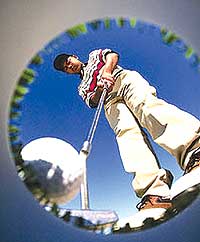 Don't believe the propaganda, golf is actually simple and easy to play. You place a small hard ball on the ground, and hit it with a long club. In as few hits as possible, try and get it into a cup in a small hole in the ground marked by a flag.
Don't believe the propaganda, golf is actually simple and easy to play. You place a small hard ball on the ground, and hit it with a long club. In as few hits as possible, try and get it into a cup in a small hole in the ground marked by a flag. A standard golf course has 18 holes, usually between 100-600 yards long, each with a tee where the first hit is made, a fairway of grass, and a smooth grass green where the hole is located. Such a simple game would soon be unfashionable. Who would aspire to be good at something so easy? Thus exotic terms have been added to make the game appear more glamorous.
Here is a guide so the uninitiated can enlighten themselves and understand the mysterious terms used by the golfing fraternity to make this simple game appear so complex.
Basic terms for a golf course's features:
Tee - The starting point, the beginning of the hole, where you hit your first of many shots to try and get the ball into the cup. This is a flat area identified by two markers spaced a few yards apart. There are different tees on each hole for men and women of different playing abilities. Nowadays each hole has four sets of tees, the furthest from the hole being the black tee markers for men's championships and professionals, slightly closer to the hole-blue markers for normal men players (that is, if any male golfer can be considered normal), white markers for seniors, men's beginners, and better juniors and ladies, and the closest to the hole red markers for ladies and beginner juniors.
Fairway - A well manicured, closely mown area between the tee and the green, usually between 30 to 60 yards wide, and down the center of the direction you should be hitting the ball. Fairway grass is cut quite short and kept in good condition to make play easier by rewarding a straight shot from the tee. The reward is a golf ball which sits nicely on top of the short grass and is easier to hit with control.
Rough - Less well maintained areas of longer grass on either side of the fairway, placed with the intention of making shots that were not hit on the fairway more difficult to play, as the ball sinks down into the longer grass.
Bunker - A pit filled with sand. It is much more difficult to play a shot from a bunker, so these are fiendish obstacles placed in strategic areas to make the game more challenging and difficult.
Hazard - Hazards include water bodies, ditches, drains and bunkers which are again placed to make the game more challenging, forcing a golfer to take into account strategies of avoiding these hazards. If you cannot hit your ball out of a hazard, you play from outside the hazard and add a one shot penalty to your score for that hole.
Out of Bounds - Outside the allowed area of play. For example, if you hit your ball into the neighbouring rice paddy field. In this case you have to add two shots to your score for that hole and hit the ball again from the same place.
Green - A flatter, smoother area, with very short evenly cut grass that allows the ball to be rolled towards and hopefully into the cup placed in the ground. This cup is 4.5 inches in diameter and is marked by thin pole placed in its center topped with a flag.
When you've finally managed to repeatedly hit the ball from the tee and get it into the cup, then play is completed for that particular hole.
Round of Golf - You must play 18 holes to complete one round of golf. Each hole has all the features revealed above, and generally a full length Golf course has 18 holes. Smaller courses have 9 holes which are played twice to complete the requisite magical number of eighteen.
(To be continued...)
Deepak Acharya is a golf instructor and Head Golf Professional at Gokarna Forest Golf Resort & Spa, Kathmandu. [email protected]



